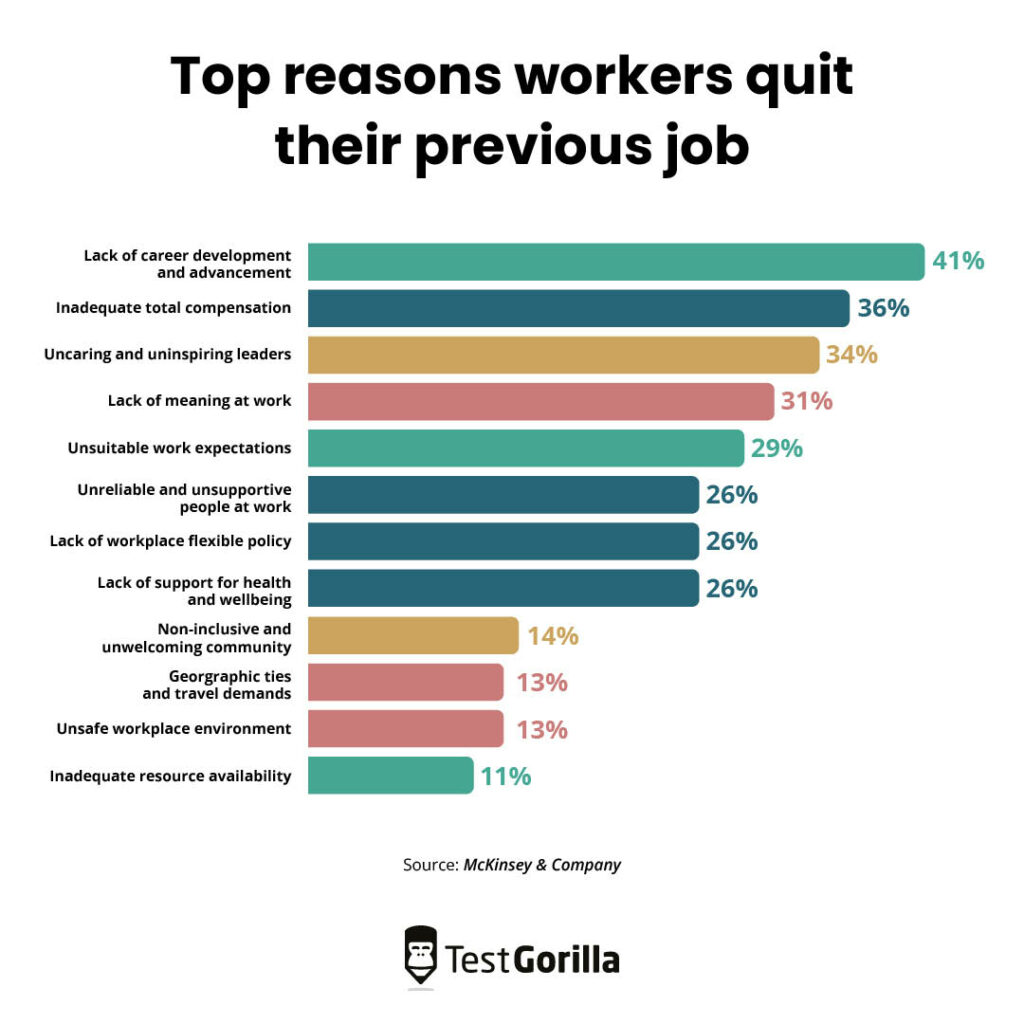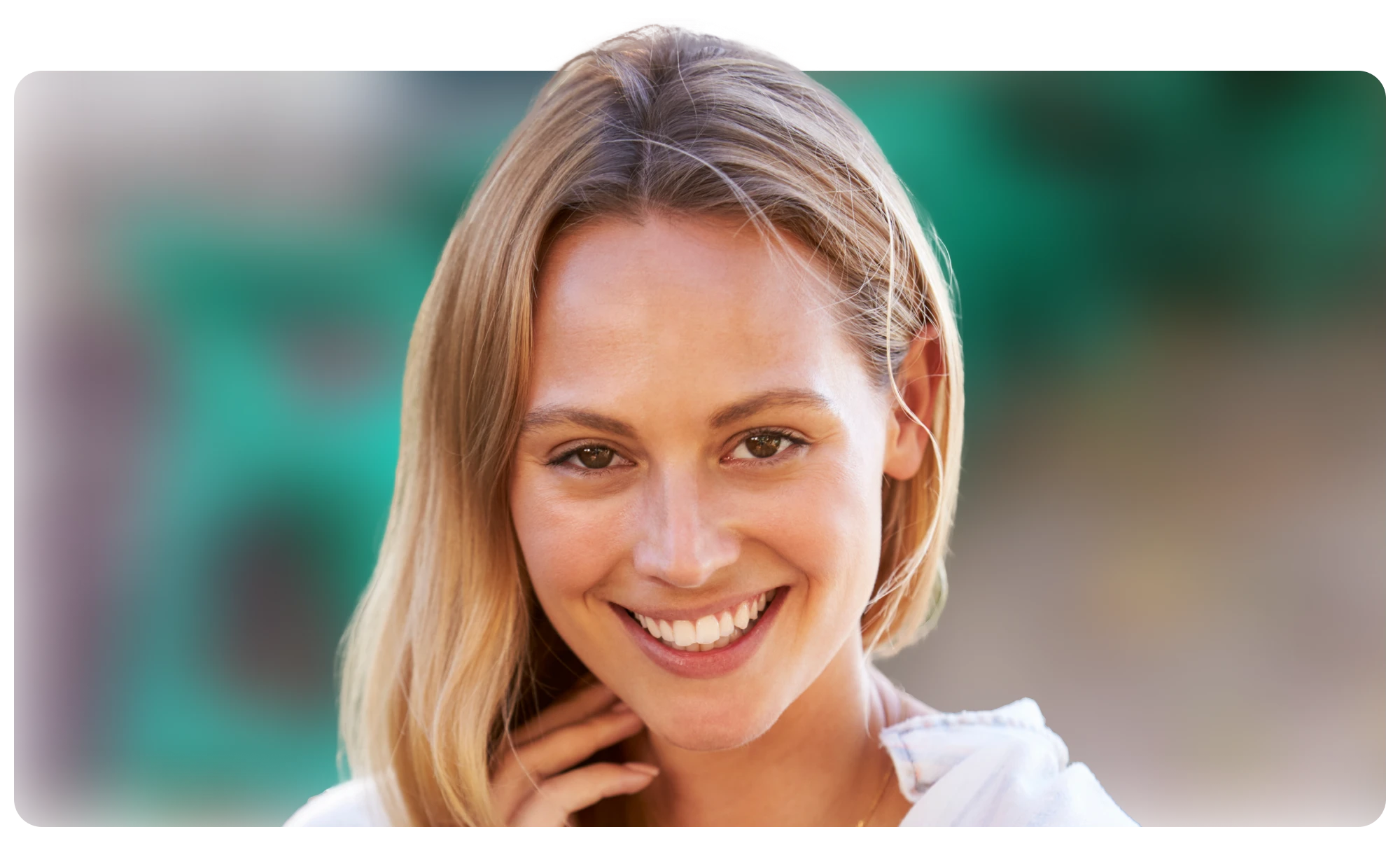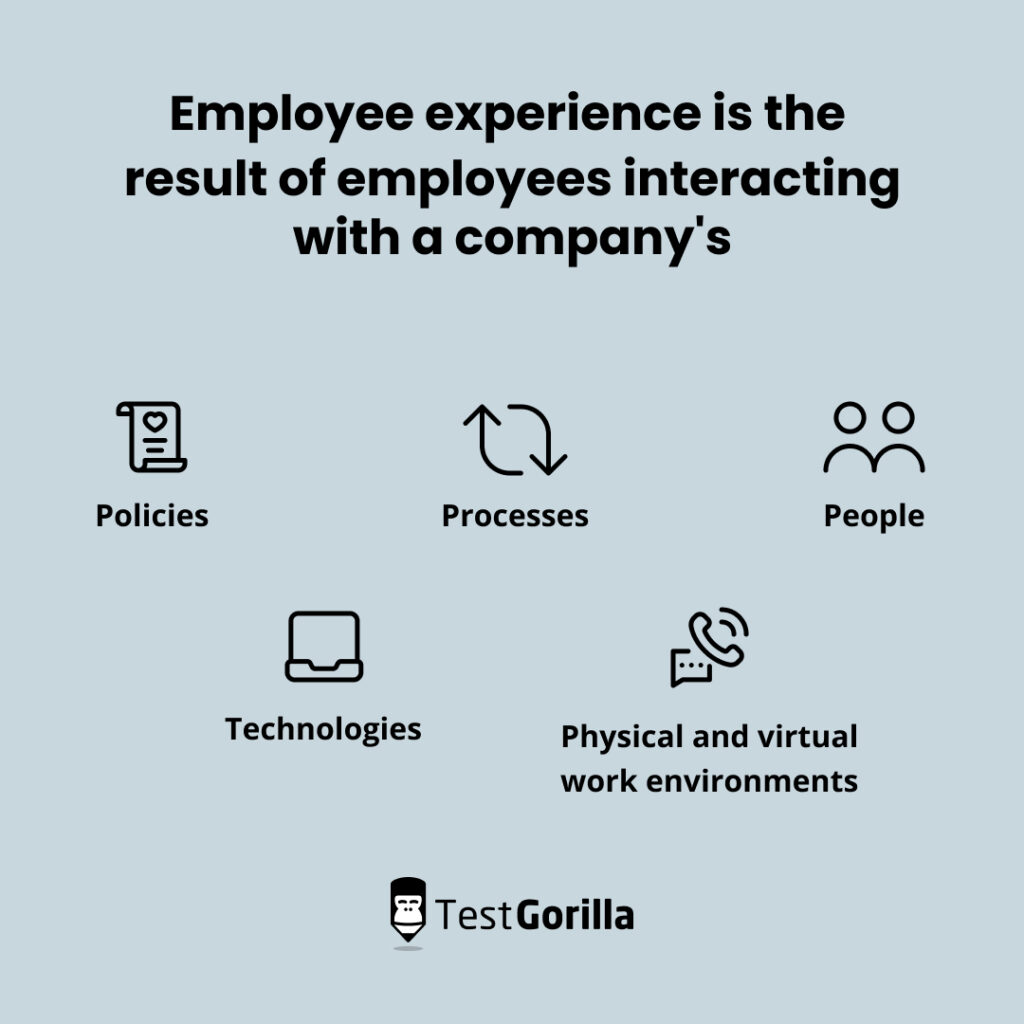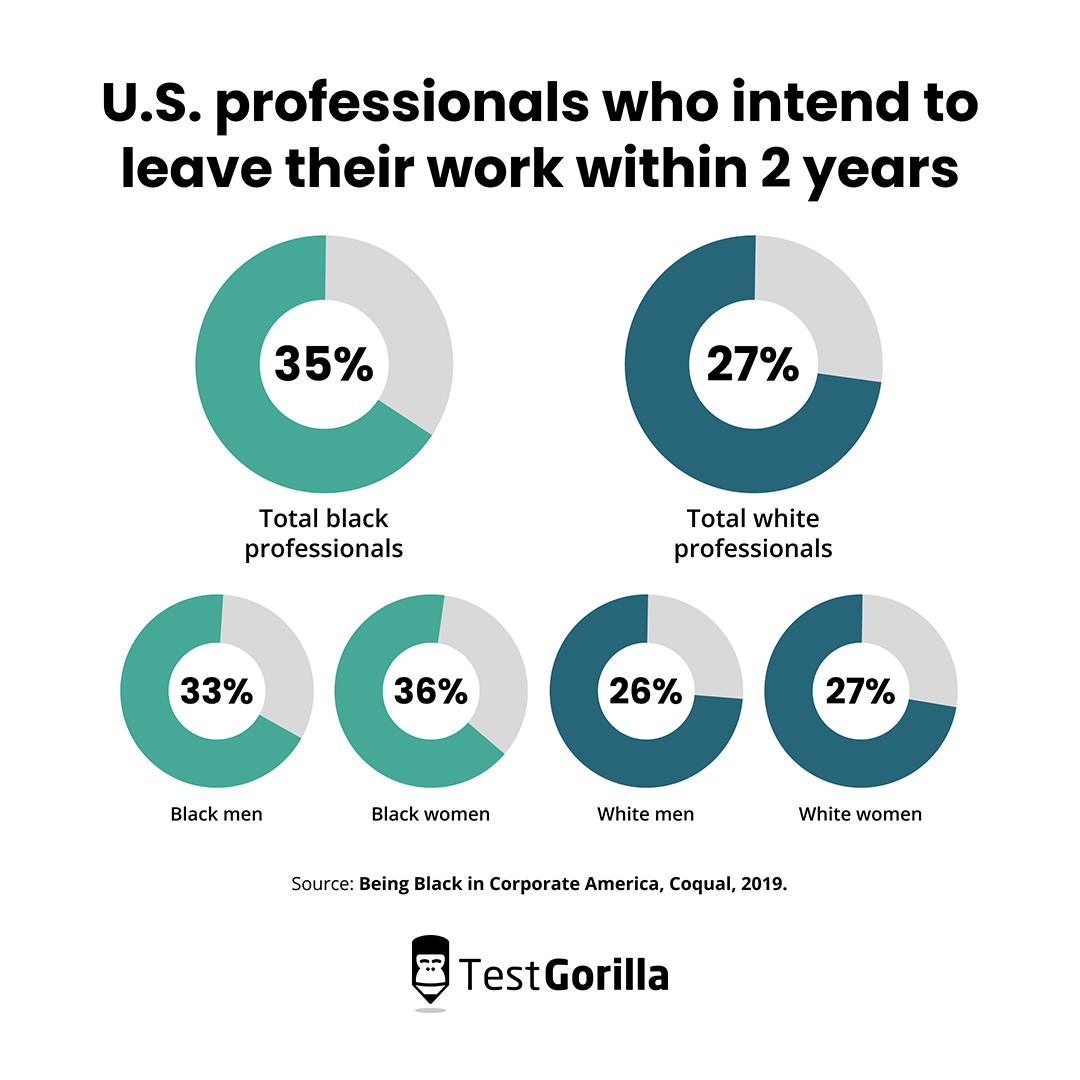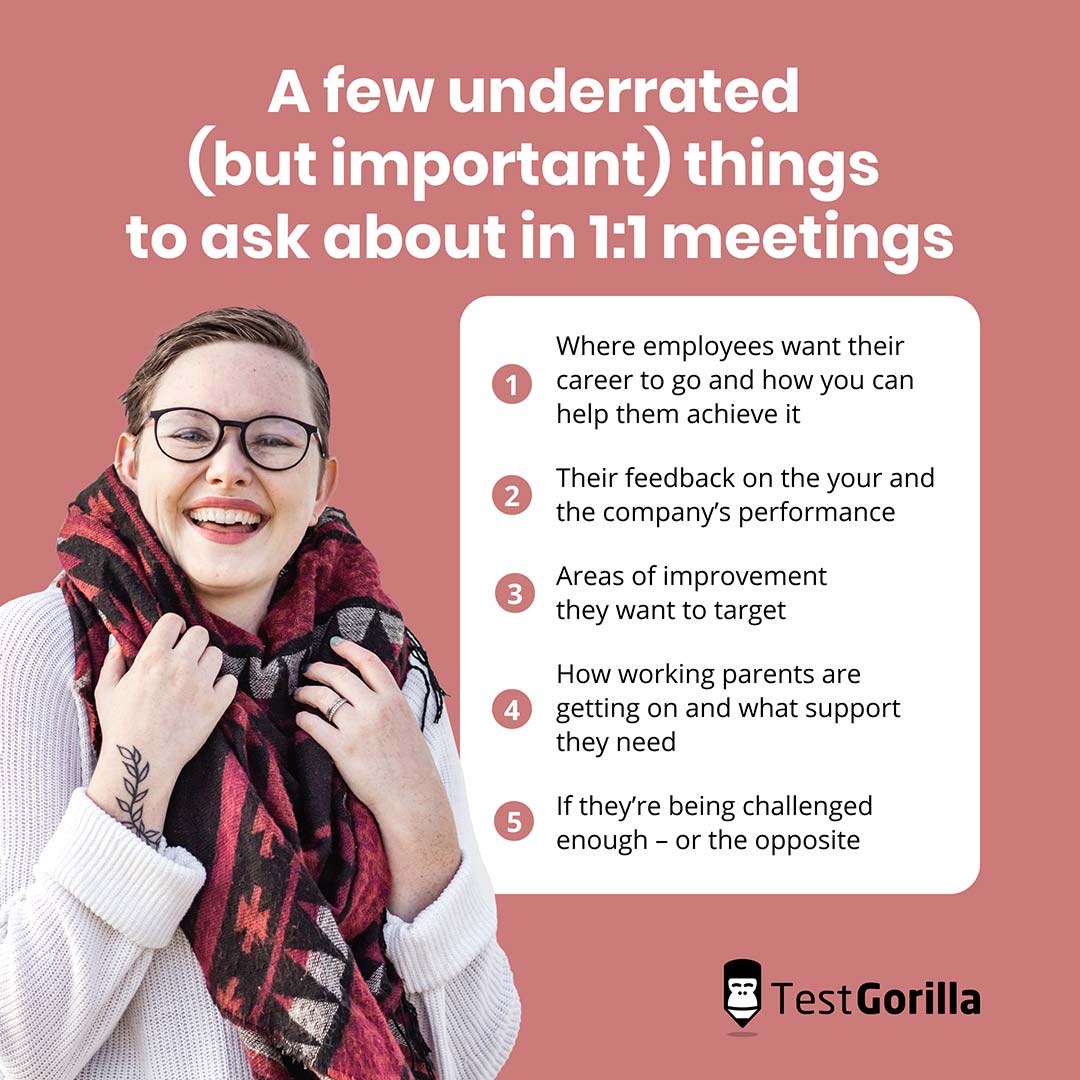The ultimate guide to employee retention strategies: 26 innovative ideas to retain talent
Losing employees is an expensive business.
Finding a replacement for a motivated employee can cost anywhere from one half to two times that employee’s annual salary.[1]
It’s not only your bottom line that suffers, either. A poor employee retention rate can be a sign of deeper issues with your company culture and processes. It could be a symptom of low engagement, burnout, or even a toxic work culture.
A focus on existing employees is sweeping the world of work in an effort to combat this issue. In this blog, we break down the best employee retention strategies to prioritize in your business.
So, what are the strategies you should use?
If you need a quick primer on what employee retention strategies are and why they’re important, keep reading.
What are employee retention strategies?
Employee retention strategies, also known as talent retention strategies, are practices and policies designed to motivate top talent to stay in a company to reduce turnover.
These strategies are created to engage and motivate employees and boost overall employee satisfaction.
Although employee retention strategies can be reactive – for example, using a retention bonus to encourage key personnel to stay during a difficult transition – in this blog, we’ll mainly refer to retention strategies that are proactive.
Instead of waiting for a spike in employee turnover or for your staff to raise specific complaints, you should take initiative to implement strategies for employee retention that improve employees’ overall experience and make them want to stay longer at your company.
Why is an employee retention strategy so important?
It’s easy to see that talent retention strategies are a positive thing for your workforce, but what makes them not only useful but also necessary?
Let’s explore the three main benefits of a well-designed employee retention strategy.
1. It reduces your turnover rate
Having a high employee turnover rate costs your organization money, damages your brand, and discourages new candidates from applying for roles.
This is because potential candidates may see a company with a high turnover rate and make assumptions about why employees are quitting.
To calculate the turnover rate in your workforce, simply divide the number of separations in a given period by the average number of employees, then multiply by 100. You can compare this to industry benchmarks to see if it’s higher than average.
2. It gives candidates active incentives to stay at your organization
Employee retention strategies are important because there are strong incentives for employees to leave organizations that aren’t working to keep them.
This is especially true in a candidate’s market, where there are more vacancies than skilled workers to fill them.
One report by Betterworks found that not only do open roles take longer to fill, but new hires can demand the highest salaries in over a decade.
You need to convince your employees that you are not just a good employer, but a better employer than your competitors – or they’re likely to jump ship: 4.5 million people quit their jobs in March 2022 alone.[2]
3. Strategies for employee retention help proactively manage your workforce
It pays to be proactive, too. A few key personnel leaving can put enough strain on your team’s resources to cause burnout and a later exodus. Don’t wait until your turnover is at a worrying high to act.
If you’re already suffering from a spike in turnover, short-term strategies like retention bonuses might help bridge the gap, but you need long-term solutions to stop it from happening again.
The best insights on HR and recruitment, delivered to your inbox.
Biweekly updates. No spam. Unsubscribe any time.
What are the causes of employee turnover?
Of course, to design innovative employee retention strategies and reduce employee turnover, you first need to know what’s causing turnover in the first place.
McKinsey research reveals that the top driver for employees to leave their employers is a lack of career development and advancement, followed closely by inadequate compensation.
The study also found that bad bosses are a bigger incentive for leaving than ever before: Employees are less and less inclined to overlook bad leadership for a big paycheck.
Other issues you need to tackle in your talent retention strategies include:
Lack of meaningful work
Unsustainable expectations
Unreliable and unsupportive coworkers
26 talent retention strategies for holding on to top workers
Drawing from the research, it’s clear that the biggest factors employers should address when crafting effective employee retention strategies are:
Leadership and hiring incentives
Fair and inclusive hiring and onboarding
Developing employees’ skills
Creating career paths for progression
Listening to employees’ feedback
Luckily, we have 26 staff retention strategies to solve these problems and boost job satisfaction amongst your workers.
26 talent retention strategies: Summary table
We’ve categorized our employee retention strategies by which issue it addresses. Here’s a quick summary of how to tackle the biggest challenges to employee retention.
26 innovative employee retention strategies | Example actions |
Leadership and hiring incentives | |
1. Encourage leaders to communicate your overall mission | Ensure leaders follow rules that apply to employees, such as not sending emails outside office hours |
2. Make inclusion a pillar of your company culture | Hire for culture add instead of culture fit |
3. Make employee experience everyone’s responsibility, not just HR | Appoint a chief experience officer to oversee employee experience improvements |
4. Be transparent about employee compensation | Post all employees’ salaries in a public portal on your site |
5. Attract top hires with a mix of traditional and nontraditional employee benefits | Offer flexible working and onsite childcare to cater to parents |
Fair and inclusive hiring and onboarding | |
6. Use talent assessments to hire the right people | Replace resume screening with talent assessments |
7. Post your job ads to different sites to boost diversity | Post job ads to the Path Forward job board to attract caregivers returning to the workforce |
8. Build and value multigenerational teams | Offer benefits to support workers of all ages, such as menopause care, as part of your healthcare package |
9. Build working relationships during preboarding | Send new employees a personalized welcome video from their team |
10. Use skills test data to tailor your onboarding process | Tailor onboarding experiences to their personality type, such as introversion vs. extroversion |
11. Offer diversity training to your staff | Train all employees about unconscious bias and test them on it one month later |
Developing employees’ skills | |
12. Be open-minded about employees’ career advancement | Create an alumni portal to keep in touch with departing employees |
13. Create tailored professional development plans for employees | Incorporate a plan for how to build weak areas of their skill sets based on talent assessments |
14. Give all employees a budget for upskilling | Give each employee the equivalent of 3.5% of their salary to spend on training |
15. Use talent assessments to evaluate employee training programs | Re-test employees using the same skills tests to measure their progress |
16. Complement formal training with personalized employee coaching | Include employee coaching alongside upskilling in development plans |
17. Try reskilling before restructuring | Use skills tests to identify candidates for redeployment |
Creating paths for progression | |
18. Log employees’ skills in an internal talent marketplace | Input all skills test results to a spreadsheet and consult this when considering candidates for promotion |
19. Put together an internal mobility task force | Include team members from different levels of the business to identify candidates for internal movement |
20. Create a culture of employee recognition | Give employees the power to award colleagues a bonus, such as a $50 gift card |
21. Include all workers in employee engagement programs | Engage remote employees by documenting all meetings online |
Listening to employees’ feedback | |
22. Track the success of your initiatives with HR analytics | Use HR analytics to track the impact on turnover from these strategies for employee retention |
23. Build a culture of one-on-one meetings | Set guidelines for 1:1 meetings that include employees giving feedback to management |
24. Start conducting “stay interviews” | Conduct a round of stay interviews when there is a big shift in the market |
25. Conduct exit surveys with all leavers – not just the ones you’re sad to see go | Use exit interviews to plan the notice period and leave a good impression |
26. Create a system to implement employee feedback | Include representatives from each department to put forward ideas for improvements |
1. Encourage leaders to communicate your overall mission
Uninspiring and uncaring leadership is a leading cause of quitting according to the McKinsey research.
With this in mind, one of the most effective employee retention strategies is to encourage leaders to clearly communicate the mission served by employees’ work.
Company culture is important to job seekers: 86% say it’s somewhat or very important when choosing a new employer.[3]
This talent retention strategy requires strong leadership communication about the organization’s:
Culture
Core values
This is about more than just words. Your leaders are role models for your company culture. If you claim to respect workers’ rest time but your leaders frequently send emails throughout the night, this undermines your message.
An example of a leadership role model is Yvon Chouinard, founder of Patagonia, the clothing giant. Chouinard backed up the company’s mission-driven model by turning the company into an environmental nonprofit in 2022.
He also role-modeled the organization’s commitment to flexibility and work-life balance as a boss. Chouinard encouraged workers to go surfing when the weather was good and modeled this himself by taking several months off a year to go fishing, during which time staff knew not to contact him.[4]
2. Make inclusion a pillar of your company culture
Although compensation issues are a leading driver of attrition, a study by MIT’s Sloan School of Management found that toxic corporate culture was more than 10 times as powerful a factor.[5]
One of the best employee retention strategies, therefore, is creating an inclusive culture for all employees.
Employees who feel included are almost three times as likely to feel committed to their employers and pursue development and promotion.[6]
You can promote inclusion at your company by:
Hiring for culture add instead of culture fit; “culture add” candidates share your company values while bringing something new to the team, limiting the chance of groupthink and cliques forming
Facilitating employees’ work-life balance with strong wellbeing initiatives like flexible working and meeting-free days
Encouraging psychological safety and encouraging employees to take risks, ask questions, and make mistakes
Consider taking a leaf out of Zillow’s book by creating “affinity networks” for marginalized groups and allies. More than half of the real estate marketplace platform’s workforce now belongs to one or more of these networks, strengthening inclusion in the company.[7]
3. Make employee experience everyone’s responsibility, not just HR
Employee experience (EX) refers to all the interactions an employee has with an organization throughout their life at a company, starting with hiring and ending after they leave.
There are numerous factors that contribute to EX, including your:
Policies
Processes
Technologies
Physical and virtual work environments
People
The HR function is naturally embedded in many of these processes, but not all of them. Managers, for example, have a much more direct role than HR reps.
Stress to leaders and managers at all levels of your organization how large their role is in creating a positive workplace and a stable workforce.
Some organizations, including Mastercard, Under Armour, and United Way, appoint a chief experience officer to manage the way different functions align on this issue.
4. Be transparent about employee compensation
Although it may not always be possible to offer higher salaries than your competitors, there are other ways to stand out in terms of employee compensation.
Instead of merely writing “competitive salary” in your job ads, put your money where your mouth is by being transparent about pay.
You might do this in individual job ads, or make salaries for all positions available in a public portal like software company Buffer.
This talent retention strategy builds trust with your employees, boosts engagement, and creates a healthier company culture.
Candidates will thank you: 98% of job seekers want to know salary information before applying for roles, and nearly three-quarters believe that pay transparency creates a fairer environment for employees.[8]
5. Attract top hires with a mix of traditional and nontraditional employee benefits
Salary isn’t the only component of a great compensation package. Offering great employee benefits is also a strong talent retention strategy.
These include traditional benefits like pensions and vacation time, but you should also consider offering nontraditional benefits like:
Financial planning
A professional development budget
Family planning and childcare
Social connections for remote and hybrid workers
Both mental and physical wellness perks
That last point is especially important. Employee wellbeing is about more than physical health, and the best employee retention strategies include initiatives like offering mental health days or covering therapy sessions.
Evidence shows that employees are 1.6 times more likely to stay with an employer that offers wellness programs and benefits.[9]
Flexible work is another employee retention strategy that can improve both employee wellbeing and retention.
Nearly three-quarters of workers say they would prefer long-term work flexibility over a pay raise.[10]
Netflix, the global streaming company, is one example. The company doesn’t have a prescribed vacation policy for salaried employees, instead allowing workers to choose their own time off, including when they need to rest and reset due to stress or illness.[11]
6. Use talent assessments to hire the right people
Retention starts with recruitment. Hiring the right people for the right roles is one of the most effective employee retention strategies because it ensures candidates have the skills to succeed and be confident in their roles.
According to TestGorilla’s State of Skills-Based Hiring report, among organizations that used skills-based hiring practices in 2024, 90% improved employee retention.
The report also found that 90% of candidates believe that being given the chance to prove their skills makes them more likely to secure their dream job.
After all, doesn’t it make sense that a high score in the SQLite Coding test would verify skills more accurately than a resume that says “excellent coding skills”?
Deloitte research backs this up: The study shows that skills-based organizations are almost twice as likely to retain high performers and more than twice as likely to be innovative.[12]
IDP Education is one example of an organization that has reduced time and money wasted on mis-hires since switching to skills-based hiring.
7. Post your job ads to different sites to boost diversity
Talent assessments can also help you boost diversity in the workplace. A study of more than 2,000 successful job applications found that the number of women hired into senior roles increased by almost 70% when skills-based hiring methods were used.[13]
Having employees of different identities and backgrounds brings cognitive diversity to teams, which is great for innovation and retention.
Catalyst research links higher levels of gender diversity and the presence of HR policies focused on this issue to lower employee turnover.[14]
To ensure that you’re bringing in as diverse a group of candidates as possible, use many different sources for applicants.
For example, you could post your ads across many different dedicated job boards for marginalized groups – Path Forward is an excellent option for caregivers returning to the workforce.
8. Build and value multi-generational teams
In addition to gender and racial diversity, employers should also pay attention to generational diversity, creating teams that comprise multiple age groups – for instance, Gen Z, millennials, and baby boomers.
Tackling age discrimination in hiring and crafting staff retention strategies to encourage harmony between these groups has numerous benefits:
Knowledge sharing
A more inclusive culture
Discouraging bullying and discrimination
Better succession planning
More perspectives and a better knowledge of customers
Multigenerational teams may even be happier.
One study found that 86% of workers prefer working on multigenerational teams; the same number said multigenerational teams are more innovative.[15]
One way to provide support to older workers is Barclays’ policy of menopause support. In 2022, the banking giant introduced treatment for menopausal symptoms into its healthcare coverage, including specialist menopause care.[14]
9. Build working relationships during preboarding
Unsupportive coworkers were another common factor in employees choosing to quit, according to McKinsey’s research. Prioritizing culture add over culture fit with skills-based hiring already goes some way toward fixing this.
Another way to bolster working relationships is to hit the ground running by introducing new recruits to their colleagues virtually before they start. You can do this through:
Written welcome messages as part of a welcome package
A video call with their manager before their first day
An informal welcome video from colleagues
A prepared welcome video from the department – perhaps even including bloopers, like this example from Royal Brompton & Harefield Hospital by Kartoffel Film.
This helps set up that all-important first impression. Speaking of which…
10. Use skills test data to tailor your onboarding process
Providing a good onboarding experience, whether through in-person or virtual onboarding, is an essential employee retention strategy.
Studies show that new hires are twice as likely to plan to leave if their onboarding experience is bad.[16]
A strong onboarding process can avoid this. This should include standard onboarding best practices like:
Using onboarding checklists
Offer new hires sessions with IT to set up their software
Communicate your culture and values
Clarify job roles and responsibilities
You should also use the personalized information you have about your new employees from their skills tests.
For example, if a candidate’s personality test results show they’re introverted, you might plan for their training to be completed mainly through independent work rather than in-person training with their team or manager.
If they are shaky on some of the basic skills for the role – such as familiarity with specific software – you can also target this in their early training.
11. Offer diversity training to your staff
We’re the first to admit that diversity training isn’t a silver bullet for workplace diversity. Yale University researchers found that even when trained on objective hiring, male and female scientists still preferred to hire men.[17]
However, in combination with a skills-based approach to hiring, we believe it can carry many of the benefits of diverse hiring into day-to-day business.
When every employee has been hired on the basis of their skills, there is less room for prejudice to color individuals’ perceptions of one another’s work. It may also make these unconscious biases easier to tackle by providing hard data on employees’ skills.
Diversity training in this environment is therefore more likely to be successful.
There are many examples of successful diversity and inclusion training programs, such as Google’s “Unconscious Bias @ Work” training.
This program significantly increased awareness and understanding of unconscious bias in the workplace. These effects persisted even one month after training.
12. Be open-minded about employees’ career advancement
Being realistic, most employers know that they can’t keep most employees forever. With this in mind, Harvard researchers recommend that companies start offboarding at the moment of hiring.[18]
This means letting current employees know you understand their career growth may one day take them outside your organization. By doing this, you create a bond of trust and mutual honesty with your workers.
It also helps you prepare to be agile in times of change. Nonlinear careers are on the rise, with employees zigzagging between roles, functions, and industries.
We may even be heading toward a future without “jobs” as we understand them now. In fact, many organizations have adopted a more project-based approach to work.
The skills-based approach prepares you and your employees for this eventuality by giving you insight into their skills.
This also increases the likelihood that if your staff does choose to leave, they might come back at a later date as boomerang employees.
To see what this looks like in practice, take Deloitte’s alumni network, an online portal that keeps past employees in the loop with one another and with available roles.[19]
13. Create tailored professional development plans for employees
We’ve already seen how important professional development is to workers. Nearly a third of employees say they would take a pay cut to work in a role they were more satisfied with.
This is increasing in importance as more Gen Z workers enter the workforce: One survey found that 67% of Gen Z employees want their employer to help them develop skills to advance their careers.[20]
Meet these expectations by offering professional development plans for your staff. These are documents that set out an employee’s career goals and the strategies and skills needed to achieve them.
To build professional development plans for your employees, ask them to complete a self-assessment, verify their skills with skills tests, and lay out the resources you can offer them.
Duke University uses this talent retention strategy – see the outline of their policy here.
14. Give all employees a budget for upskilling
Some studies suggest that the number one reason people quit is a lack of learning and development opportunities.[21]
One way to tackle this is by putting employees in charge of their learning by providing them with a budget for upskilling.
We use this strategy at TestGorilla. We give each of our employees the equivalent of 3.5% of their salary in funding for learning and development opportunities, which they can spend as they wish – all they need is a sign-off from their manager.
This gives employees more autonomy over their development while also tackling the dire need to stay up to date with changing skills requirements.
The results are striking: More than 90% of chief executive officers who implement upskilling programs see gains in productivity.
They also see more resilience among workers and improvements in talent acquisition and retention.
15. Use talent assessments to evaluate employee training programs
So far, you’ve created professional development programs to guide employees’ growth and given them a budget to fuel that learning.
Now, it’s time to track their trajectory through their employee training programs and, importantly, find out which providers are worth sticking with.
Luckily, skills-based methods go hand in hand with employee development.
Not only can you use skills tests to target employee training and development initiatives, but you can use them to benchmark their progress.
For example, retest employees’ skills at various intervals after a one-day program to see how they’ve retained the information. Then retest them periodically as they move through longer-term training.
This helps you notice if their engagement drops. It also enables you to compare employees’ progress with different providers and make a stronger case to leadership about the return on investment you get from learning and development initiatives.
16. Complement formal training with personalized employee coaching
Formal training is best complemented with another talent retention strategy: employee coaching.
Employee coaching is different from mentorship, which usually emphasizes the experiences of the mentor in the advice they give to their mentee.
Coaching is a more personalized approach, specifically focused on closing the gap between an employee’s current abilities and their goals.
It can be an especially useful employee retention strategy for ensuring that people from marginalized groups get into companies and progress through them.
This is an issue for many professionals of color, who find that prejudices within the workplace bar them from progressing once they have a foot in the door.[22]
The combination of skills-based hiring, diversity training, and personalized coaching can alleviate these issues.
An example of successful employee coaching comes from In Equilibrium, who helped a deputy headteacher attain the headship by using personality testing to inform their coaching approach.[23]
17. Try reskilling before restructuring
Employee retention strategies often reach their breaking point when a company falls on hard times. Restructuring and laying off employees can decimate efforts to maintain a positive culture.
The negative consequences of layoffs include:
Increased supervisor aggression
Reduced friendship formation
Fewer advancement opportunities [24]
All of these are aggravators for employees when it comes to quitting, but using skills testing in strategies for retention can help you avoid them.
If you’re heading into a period of restructuring, limit layoffs by reskilling existing workers into necessary roles.
For instance, Seagate, a data storage solutions company, pursued strategic redeployment for its employees during the COVID-19 pandemic instead of mass layoffs.
The result was $13m in savings from external hiring costs, $20m in savings from termination cots, and 30% of full-time roles being filled internally.[25]
18. Log employees’ skills in an internal talent marketplace
Skills test data is an invaluable resource. To make the most of it, collect it into an internal talent marketplace – software or a simple spreadsheet laying out the skills resources available within your organization.
Internal talent marketplaces make it easier to spot candidates for promotion – and to do so more fairly than with traditional methods, which can be affected by bias.
For example, women are less likely to be promoted than their male colleagues, despite outperforming them and being less likely to resign.[26]
Internal talent marketplaces can also help you:
Identify candidates for internal hiring
Assemble cross-functional teams
Spot reskilling opportunities
Schneider Electric implemented this employee retention strategy, and within two months, 60% of the workforce had used it. Now, more than 80% say they’d recommend it to colleagues.[21]
19. Put together an internal mobility task force
Many of the development-focused strategies for employee retention above are geared toward one key goal – facilitating internal mobility.
This is vital to increasing retention. Employees who are promoted within three years of hiring are 70% more likely to stay with the company; those who make lateral moves are 62% more likely to stay.
By contrast, those who don’t move internally have only a 45% chance of remaining long-term.[27]
To do this, assemble an internal mobility task force whose job it is to spot opportunities for movement within the company. Here’s who should be on the team:
Team member | What they bring |
Head of people | A vision of the organization’s overall goals Strategic control of internal mobility initiatives Influence with the senior management team |
Learning and development manager | Knowledge of available learning and development resources The ability to turn higher-level strategies into action |
Line managers | Direct contact with employees Day-to-day knowledge of the skills gaps and opportunities within their teams |
20. Create a culture of employee recognition
Recognition ranks higher as an incentive for hard work than promotions, higher pay, autonomy, and training – so why do so few employees get the recognition they need?[28]
Although 67% of managers believe they are above average at praising and recognizing employees, only 23% of employees agree.[29]
To incorporate recognition into effective employee retention strategies, employers must build a culture of recognition. Here are some ideas for how to do it:
Include a moment for recognition during weekly huddles
Implement a “kudos” channel on your group chat through Slack or Google Chat
Recognize the achievements of all employees and leave no one out
Gamify the recognition process
Give workers a chance for public recognition (on social media or the company website)
At Zappo, an online clothing retailer, employees can reward one another with a $50 coworker bonus. They can each award one bonus per month, but they can receive more than one as long as they’re awarded by different colleagues.[30]
For more insights, read our guide to employee recognition.
21. Include all workers in employee engagement programs
The staff retention strategies above are effective because many of them target employee engagement.
The key to their success is ensuring you include as many employees in your engagement strategies as possible. After all, diverse hires may not stick around if their needs aren’t met – and that puts you back at square one.
One way to make your staff engagement programs inclusive, especially if you are a hybrid employer, is to engage remote employees as intentionally as in-office workers.
Unfortunately, for many managers of remote workers, out of sight is out of mind:
42% of supervisors say they sometimes forget about remote workers
34% of remote workers believe remote work reduces their career opportunities
29% of remote workers say they have fewer development opportunities[31]
The best employee retention strategies can combat this.
One company doing this right is Automattic, which is best known as the parent of WordPress. Automattic is a distributed – or in other words, fully remote – company that engages all workers by:
Documenting everything so everyone has access to the decision-making process
Communicating online as much as possible so it’s universally accessible and easy to catch up
Meeting up face-to-face once a year for socializing and strategizing
Providing a stipend for employees to create their ideal workspace[32]
22. Track the success of your initiatives with HR analytics
You’re likely already using some form of talent acquisition analytics to manage your employment funnel and attract competitive candidates to your job listings.
However, you should also be using HR analytics to measure the impact of your initiatives – including hiring – on your overall business performance.
These analytics are especially useful when supercharged with skills assessment data. For example, try tracking how a team’s performance improves after the implementation of skills training or when you’ve used skills tests to hire new personnel.
You can also compare how the staff retention strategies we’ve outlined above have actually impacted your retention.
This gives you the valuable opportunity to switch up a strategy that’s not working or demonstrate to leadership that successful schemes deserve more investment.
23. Build a culture of one-on-one meetings
Not all innovative employee retention strategies have to be high-tech. Regular one on one meetings (think every one to two weeks) are also effective.
Great one-to-ones aren’t only status updates: They also cover employee growth, general wellbeing, and feedback from both parties.
A few underrated (but important) things to ask about in 1:1 meetings include:
Where employees want their career to go and how you can help them achieve it
Their feedback on the performance of you or your company
Areas of improvement they want to target
How working parents are getting on and what support they need
If they’re being challenged enough – or the opposite
This can massively improve communication across your organization. Don’t believe us? The founder and chief executive officer of Groove HQ, a sales engagement platform, started having one-on-one meetings with every employee, inviting both positive and negative feedback.
He found that this honesty quickly infiltrated other communication channels, including Slack.[33]
24. Start conducting “stay interviews”
You’ve heard of an exit interview, but why should you wait for an employee to leave to find out what’s kept them at your company – or what’s driving them away?
Stay interviews are when an employer discusses what an employee likes about a company and their suggestions for improvements.
These interviews help HR professionals understand which staff retention strategies are and aren’t working.
Calling in employees for stay interviews shouldn’t be nerve-racking for them. Tell them to think of it as a reverse performance review – the responsibility is on you to listen and take in feedback.
You might conduct stay interviews regularly or in response to shifts in the market. For example, many Canadian organizations started conducting stay interviews as a response to the Great Resignation to understand how the change was affecting their workforce and head off any negative impact.
25. Conduct exit interviews with all departing employees – not just the ones you’re sad to see go
An exit interview, or exit survey, is used to understand why employees decide to leave. They help you improve your processes and prevent future turnover.
Research suggests that exit interviews are not only for gaining useful feedback, but in fact may be even more useful as an opportunity to leave a good impression on departing employees, plan their exit from the company, and maximize their chances of returning.[34]
Here are some example exit interview questions:
“What led you to start searching for a new job?”
“What did you like best and least about your job and this company?”
“Do you think your job has changed since you were hired?”
“Do you feel you were given adequate support, resources, and tools to succeed in your job?”
To find out more, read our extensive guide to exit interviews.
26. Create a system to implement employee feedback
Finally, employee feedback is meaningless unless you take it seriously. In fact, it can even be damaging to your retention if employees believe that they aren’t being listened to.
This is more common than you think: Nearly half of regular employees and 40% of executives don’t believe their feedback contributes to meaningful change.[35]
Consider creating an employee feedback committee, with representatives from each team or department bringing in suggestions from their team for changes that could be made.
The results of these meetings could be made public to the rest of the company, creating an opportunity for workers to vote on big changes.
You could also use an employee listening tool to gather feedback. TotallyMoney, a fintech company, took this approach, using the insights gained to restructure its data team to make employee development easier.
It also improved employee communication by inviting staff at all levels to speak at weekly breakfast meetings.
These innovative employee retention strategies were a resounding success: Turnover at the company fell from 64% to 23%.[36]
Skills-based hiring is the cornerstone of all the best employee retention strategies
In this blog, we’ve covered how to implement innovative employee retention strategies in your:
Leadership
Hiring and onboarding
Employee skills development
Internal mobility initiatives
Employee listening activities
By employing effective employee retention strategies, you can attract and retain the best talent, even through turbulence in the wider workforce.
To understand the developments currently affecting employee turnover, read our blog post about employee retention trends.
To improve your hiring process and find candidates who stick around, read our guide to talent acquisition strategies.
Or, if you’re already hiring and want to ensure your new recruit adds to your culture, use our Culture Add test to hire the best.
Sources
1. McFeely, Shane; Wigert, Ben. (March 13, 2019). “This Fixable Problem Costs U.S. Businesses $1 Trillion”. Gallup. Retrieved October 18, 2023. https://www.gallup.com/workplace/247391/fixable-problem-costs-businesses-trillion.aspx
2. “Job Openings and Labor Turnover – March 2022”. (May 3, 2022). Bureau of Labor Statistics. Retrieved October 18, 2023. https://www.bls.gov/news.release/archives/jolts_05032022.pdf
3. “Job Seeker Nation Report: The Rise of the Optimized Workforce”. (2021). Jobvite. Retrieved October 18, 2023. https://media.trustradius.com/product-downloadables/EM/T5/Z3P0QKQTWLIN.pdf
4. Clifford, Catherine. (December 23, 2016). “The founder of Patagonia fishes half the year and tells his employees to go surfing”. CNBC. Retrieved October 18, 2023. https://www.cnbc.com/2016/12/23/founder-of-patagonia-fishes-half-the-year-tells-his-employees-to-surf.html
5. Sull, Donald; Sull, Charles; Zweig, Ben. (January 11, 2022). “Toxic Culture Is Driving the Great Resignation”. MIT Sloan Management Review. Retrieved October 18, 2023. https://sloanreview.mit.edu/article/toxic-culture-is-driving-the-great-resignation/
6. “Understanding organizational barriers to a more inclusive workplace”. (June 2020). McKinsey & Company. Retrieved October 18. 2023. https://www.mckinsey.com/~/media/McKinsey/Business%20Functions/Organization/Our%20Insights/Understanding%20organizational%20barriers%20to%20a%20more%20inclusive%20workplace/Understanding-organizational-barriers-to-a-more-inclusive-workplace.pdf
7. “‘Racism has no home here’: How employees find support and take action within Zillow’s affinity networks”. (June 2, 2020). Zillow Group. Retrieved October 18, 2023. https://www.zillowgroup.com/news/racism-has-no-home-here/
8. “Measuring attitudes towards salary transparency”. (2022). Talent.com. Retrieved October 18, 2023. https://4253253.fs1.hubspotusercontent-na1.net/hubfs/4253253/Talent.com%20-%20Measuring%20Attitudes%20Towards%20Salary%20Transparency.pdf
9. “The Rise of the Whole Employee: 20 Years of Change in Employer-Employee Dynamics”. (2022). MetLife. Retrieved October 18. 2023. https://www.rbgcal.com/wp-content/uploads/2016/03/MetLife-Employee-Benefit-Trends-Study-2022.pdf
10. “Why Employees Prefer Hybrid Working To A 10% Pay Rise – And What It Means For Business”. (September 13, 2021). International Workplace Group. Retrieved October 18. 2023. https://old.iwgplc.com/MediaCentre/Article/why-employees-prefer-hybrid-working-to-pay-rise
11. “Work Life Philosophy”. Netflix Jobs. Retrieved October 18, 2023. https://jobs.netflix.com/work-life-philosophy
12. Cantrell, Sue, et al. (September 8, 2022). “The skills-based organization: A new operating model for work and the workforce”. Deloitte Insights. Retrieved October 18. 2023. https://www2.deloitte.com/us/en/insights/topics/talent/organizational-skill-based-hiring.html
13. Sundaram, Khyati. (March 13, 2022). “‘Skills-Based’ Hiring Driving 70% Increase In Senior Role Hires For Women Hired”. The HR Director. Retrieved October 18. 2023. https://www.thehrdirector.com/business-news/diversity-and-equality-inclusion/skills-based-hiring-drives-a-70-increase-in-the-number-of-women-hired-for-senior-roles/
14. “Why Diversity and Inclusion Matter (Quick Take)”. (June 24, 2020). Catalyst Research. Retrieved October 18, 2023. https://www.catalyst.org/research/why-diversity-and-inclusion-matter/
15. “Randstad Workmonitor Q2 2018 Report”. (2018). Randstad. Retrieved October 18, 2023. https://workforceinsights.randstad.com/hr-research-reports-workmonitor-q22018
16. Bolden-Barrett, Valerie. (May 3, 2018). “New hires are twice as likely to leave employers that mishandle the onboarding process”. HR Dive. Retrieved October 18, 2023. https://www.hrdive.com/news/new-hires-are-twice-as-likely-to-leave-employers-that-mishandle-the-onboard/522384/
17. Agarwal, Pragya. (December 3, 2018). “Unconscious Bias: How It Affects Us More Than We Know”. Forbes. Retrieved October 18, 2023. https://www.forbes.com/sites/pragyaagarwaleurope/2018/12/03/unconscious-bias-how-it-affects-us-more-than-we-know/?sh=3333fe6e13e7
18. Dachner, Alison M.; Makarius, Erin E. (March-April 2021). “Turn Departing Employees into Loyal Alumni”. Harvard Business Review. Retrieved October 18, 2023. https://hbr.org/2021/03/turn-departing-employees-into-loyal-alumni
19. “The Deloitte alumni network”. Deloitte. Retrieved October 18, 2023. https://www2.deloitte.com/ca/en/pages/careers/topics/alumni.html
20. “2022 Career Interest Survey”. (2022). National Society of High School Scholars. Retrieved October 18, 2023. https://www.nshss.org/lp/2022-career-interest-survey/
21. “2019 Retention Report”. (2019). Work Institute. Retrieved October 18. 2023. https://info.workinstitute.com/hubfs/2019%20Retention%20Report/Work%20Institute%202019%20Retention%20Report%20final-1.pdf
22. Rabasca Roepe, Lisa. (February 06, 2021). “Barriers for Black Professionals”. Society for Human Resource Management. Retrieved October 18, 2023. https://www.shrm.org/hr-today/news/all-things-work/pages/racism-corporate-america.aspx
23. “Case Study: Using Coaching For Career Progression And Life Balance”. In-Equilibrium. Retrieved October 18, 2023. https://www.in-equilibrium.co.uk/corporate-coaching-case-studies/coaching-for-career-progression-and-life-balance/
24. Frone, Michael R; Blais, Ann-Renee. (February 2020). “Organizational Downsizing, Work Conditions, and Employee Outcomes: Identifying Targets for Workplace Intervention among Survivors”. International Journal of Environmental Research and Public Health. Retrieved October 18, 2023. https://www.ncbi.nlm.nih.gov/pmc/articles/PMC7037986/
25. Gregerson, Austin. (October 25, 2022). “5 successful examples of reskilling and upskilling programs”. Gloat. Retrieved October 18, 2023. https://gloat.com/blog/5-successful-examples-of-reskilling-and-upskilling-programs/
26. Somers, Meredith. (April 12, 2022). “Women are less likely than men to be promoted. Here’s one reason why”. MIT Sloan. Retrieved October 18, 2023. https://mitsloan.mit.edu/ideas-made-to-matter/women-are-less-likely-men-to-be-promoted-heres-one-reason-why
27. Maurer, Roy. (March 15, 2020). “Study: Internal Mobility Boosts Retention”. Society for Human Resource Management. Retrieved October 18, 2023. https://www.shrm.org/resourcesandtools/hr-topics/talent-acquisition/pages/internal-mobility-boosts-retention.aspx
28. Hastwell, Claire. (March 2, 2023). “Creating a Culture of Recognition”. Great Place to Work. Retrieved October 18, 2023. https://www.greatplacetowork.com/resources/blog/creating-a-culture-of-recognition
29. McKnight, Lori. (March 26, 2020). “Recognition Is Essential, Now More Than Ever”. Forbes. Retrieved October 18, 2023. https://www.forbes.com/sites/forbescommunicationscouncil/2020/03/26/recognition-is-essential-now-more-than-ever/
30. Von der Heydt, Andreas. (February 9, 2014). “How Zappos WOWs Its Employees”. LinkedIn. Retrieved October 18, 2023. https://www.linkedin.com/pulse/20140209220747-175081329-how-zappos-wows-its-employees/
31. “SHRM Research Reveals Negative Perceptions of Remote Work”. (July 26, 2021). Society for Human Resource Management. Retrieved October 18, 2023. https://www.shrm.org/about-shrm/press-room/press-releases/pages/-shrm-research-reveals-negative-perceptions-of-remote-work.aspx
32. “Why working from home is good for business | The Way We Work, a TED series”. (February 19, 2019). YouTube. Retrieved October 18, 2023. https://youtu.be/x6fIseKzzH0
33. Turnbull, Alex. “How Regular One-on-One Meetings Saved Our Company Culture”. The Groove Blog. Retrieved October 18, 2023. https://www.groovehq.com/blog/one-on-one-meetings-for-company-culture
34. Konig, Cornelius J; Richter, Manuela. (March 2022). “Exit interviews as a tool to reduce parting employees’ complaints about their former employer and to ensure residual commitment”. Management Research Review. Retrieved October 18, 2023. https://www.researchgate.net/publication/352977550_Exit_interviews_as_a_tool_to_reduce_parting_employees'_complaints_about_their_former_employer_and_to_ensure_residual_commitment
35. “Employee Feedback Survey Report”. (2021). Explorance. Retrieved October 18. 2023. https://explorance.com/wp-content/uploads/explorance-resource/employee-feedback-survey-report-explorance.pdf
36. “TotallyMoney reduced employee turnover from 64% to 23%”. Workday. Retrieved October 18, 2023. https://www.workday.com/en-gb/customer-stories/q-z/totallymoney-employee-voice-reduced-turnover.html
You've scrolled this far
Why not try TestGorilla for free, and see what happens when you put skills first.



